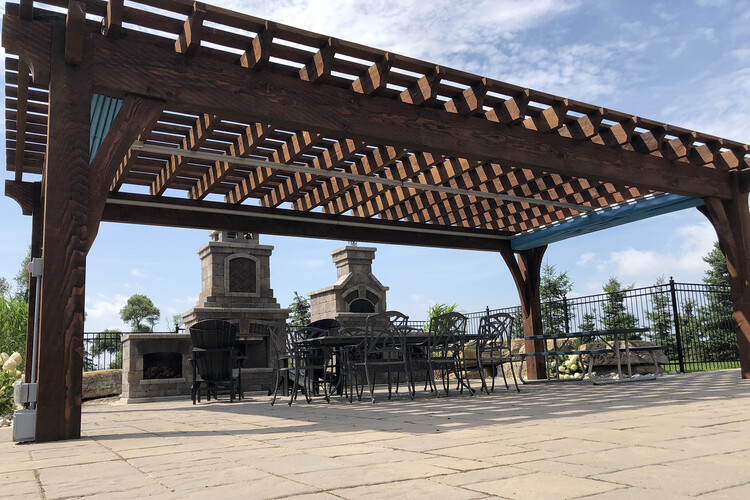
The primary function of architecture, and possibly the most important and basic, is to protect against the weather. Whereas our ancestors would stack tree trunks and animal skins to create rudimentary shelters against the sun and rain, the emergence of architecture took on impressive proportions, creating temples and captivating spaces that fulfill many other functions. The purpose of sheltering people from the outdoors, however, remains an important one and can turn an outdoor area into a functional and engaging space. With all the innovations that currently exist, there are also numerous improvements emerging for their mechanisms and functions.
When looking for the ideal solution for shade and protection, it is crucial to consider its lifespan, quality, versatility and functionality. Enter ShadeFX: They provide custom-made sun and rain solutions to fit any residential or commercial project. With a mission to bring comfort and style to outdoor living, ShadeFX published an exhaustive comparison between its products and the traditional options present on the market. Read on to see how their robust weather solutions stack up against alternative products.
ShadeFX Retractable Roofs Vs. Louvered Roofs

Louvered roofs are built with slanted horizontal slats that rotate up to 180 degrees to let sunlight in. However, they tend to only provide a limited view of the sky, due to the close proximity of the louvers. In contrast, ShadeFX's retractable roofs can be fully opened, extended or stopped at any point at the push of a button. The system can also be customized with a translucent material, allowing sunlight to pass through, while still providing shade. Additionally, it is manufactured to fit any existing structure, adapting easily to all pergolas, arbors, trellises and outdoor structures.
ShadeFX Retractable Canopies Vs. Retractable Awnings

Awnings are popular structures used in many urban spaces around the world. They are considered as a cheaper alternative to ShadeFX as they offer limited capabilities and customization. Mainly designed as shading devices, they can also be used to shield users from light rain. They require careful maintenance, such as making sure they are retracted in case of heavy rainfall or are left to dry when wet to avoid the formation of mold. Lastly, awnings must be attached to a vertical wall of a building, restricting its placement and limiting its scope.

ShadeFX retractable canopies are suspended from a single track and are customized to fit any structure. On the other hand, this patented technology produces a peak which forces rain water to run off on either side of the canopy, especially during heavy rainfall. As a bonus, gutters can be installed to further manage the water flow, directing it exactly where you want it to go. The design of the canopies also allows air to pass through its fabric, even when retracted, making it resistant to mildew and mold. In addition, the canopies are tailor-made to project specifications and can track the shapes of a curved structure or circumvent intrusive objects such as chimneys or notches.
ShadeFX Retractable Canopies Vs. Sun Sails

Based on the basic technology of ship sails, a sun sail is a device for creating external shade through a flexible membrane that is tensioned between various anchor points. Usually a permanent solution, they are mainly designed for sun protection and can only handle light rainfall; strong rain can cause the tensioned fabric to accumulate water over time and stretch.

Retractable canopies, in turn, are engineered for rain protection, offering a range of fabric options for different needs. The canopy system can be easily extended using a handle, rope or engine drive. Unlike traditional sun sails – which require a minimum of 3-4 anchor posts or points that must be firmly tensioned – ShadeFX retractable canopies only require an overhead structure such as a pergola to mount the drive beam, making it very versatile. Furthermore, a range of UV-resistant fabrics are available for optimal sun protection.
ShadeFX Freestanding Canopies Vs. Umbrellas
It is estimated that umbrellas have been around for 4,000 years and were developed in ancient Egypt. Widely used around the world, they can now be portable or fixed through a firm base, and tend to have a flexible impermeable fabric surface that can be closed and opened as needed.

However, umbrellas can considerably reduce space, and are known for their structural instability and low wind tolerance. In contrast, the system developed by ShadeFX is better described as a large two-post structure, which can be expanded as needed, has an aluminum structure and is low-maintenance. In addition, the canopy has 3 default tilt positions that come with the installation/assembly, all of which are highly stable and wind-resistant.

Pavilions are essentially buildings without walls; outdoor structures that add a new element to a deck or courtyard. An important factor in projecting this type of structure is protection from the elements. However, when it comes to sunshine or shade, there is no flexibility in fixed-ceiling pavilions, which can also be much more expensive to build. Retractable shades provide the flexibility of having full, partial or no coverage, when needed.

Thus, structures with retractable shades are excellent alternatives that provide a variety of uses, combined with resource savings and constructive simplicity. Users can decide how much sunshine and shade they want, as well as how much space they want it to take up. If a pergola is attached to a house, the shade it creates can provide cooling temperatures by protecting windows from the sun. In winter, the canopy can be removed, allowing the sun to bathe the building with its warmth.
Learn more about the comparisons developed by ShadeFX and its products in our catalog.











